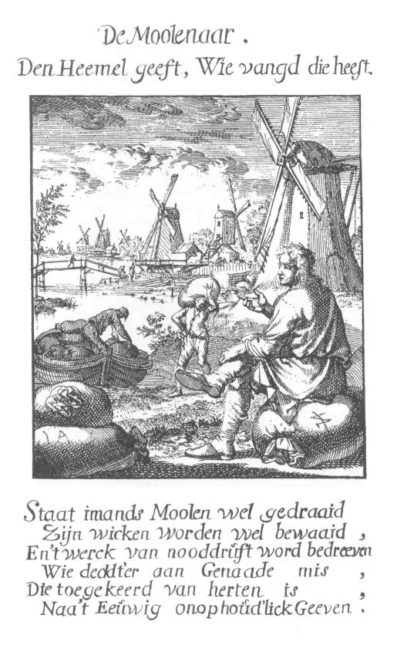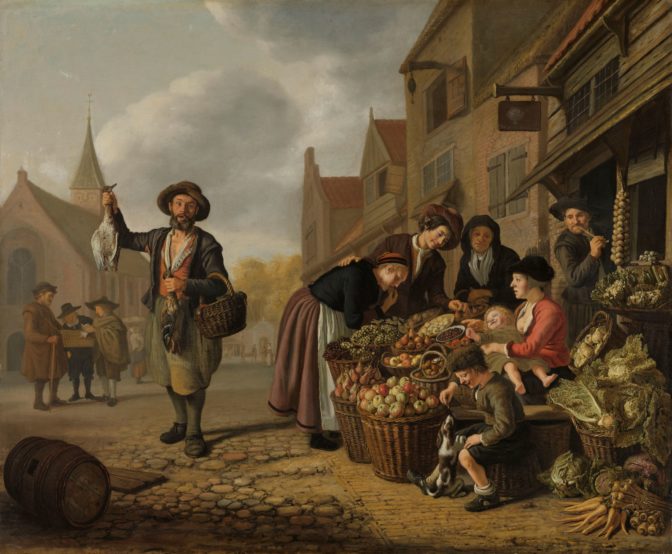Do you want to know what your Dutch ancestor did for a living? Here are five different sources you can check to find out.
Civil registration records
The civil registration records of birth, marriage, and death will include the occupation of the adults in the records (parents, spouses, deceased). These records are available for the whole country since 1811, and since 1794/6 for parts of Limburg and Zeeland. Most of these records can be found online.

Miller. Credits: Jan and Casper Luyken, circa 1690, via Picturing the Past (public domain)
Census records and population registers
Besides recording who lived where during a period, population registers also include the occupation of the adults on the page. Keep in mind that these registers were typically updated during a ten-year-period, and changes in occupation were not always recorded. These registers are available for the whole country since 1850, but from the early 1820s in some parts of the Netherlands. Census records, going back to 1811, have the same information. Most of these records can be found online.
Tax records
There were many different types of tax records that can tell you what occupation your ancestor had. For example, hearth tax records may show if your ancestor had an oven for baking, implying he was a baker. Patent tax records in the 1800s show if your ancestor had an independent trade, requiring a patent. Property tax records may show if your ancestor owned a farm, and what he grew there. Death duties files often list the occupation of the deceased and his heirs. They will also give you an indication of the financial position of your ancestor.
Guild records
Until 1795, many trades in the Netherlands were limited to members of trade guilds, such as weavers, shoemakers, coopers, and brewers. Guild records, often found at municipal or regional archives, can show the names of their members. Your ancestor could even have had a prominent position in the guild, such as being the guild guardian or chairman.
Notarial records and court records
If your ancestor was involved in trade, business transactions could have been recorded.
Voluntary transactions, such as sales, shipping contracts, or powers of attorney, were recorded by notaries. Before 1811, not all regions had notaries, in which such transactions were recorded by the court in their voluntary protocols. Notarial records can typically be found in regional archives. Several of them are being scanned and indexed.
Business disputes could lead to civil cases before the court. Court records of the local courts or courts of appeal can show information about the business deals. Most of these records are not available online yet.

The Greengrocer. Credits: Jan Victors, 1654, collection Rijksmuseum (public domain)
Where to find these records
To find out what records are online, check the Digital Resources Netherlands and Belgium website for the province where your ancestor lived. For records that are not online, check the online finding aids at the website of the regional or local archives. Most finding aids can also be accessed via Archieven.nl or Archives Portal Europe. These websites have an English user interface, but you’re searching Dutch content so only Dutch words, or placenames, will be found.


I am finding some challenges in my research because I don’t speak Dutch and the online translator programs, though very helpful, still leave me wondering about how to read a document (sentence structure), know exactly what town or village and municipality are the actual place of birth death marriage, or figuring out what an occupation really is (ie, daghuurder = day tenant but what does that mean?). I am in the process of going through internet documents to figure out just how the political land areas are set up – so far – I’ve learned that there are Large COROP regions, Provinces, smaller COROP regions within each Province then municipalities are located in these smaller regions then there are larger population areas and smaller villages and hamlets. Nothing I have found so far is consistent in how it is presented and I struggle to know what is a smaller village and hamlet where my ancestors lived within the municipality and its larger towns.
MY QUESTIONS:
How do you read a date on a document?
How do you accurately read the town, and municipality in a record?
Is there a good list of occupations in Dutch and English that actually describes the work provided by different occupations?
What are the important words in reading a document to make sure the data I am transferring is correct? (I found that older documents don’t necessarily use the word geborte but describe the mother having a child or the word overlijden but a description for a person’s death.)
It might be helpful to address some of these issues in the blog. I know I’m not the only one struggling with the questions. I find that most people just rely on the indexes and as you stated, they are not always accurate nor have they been translated accurately.
Thanks, Carol (PS my grandma was Margaretha Witteveen born in Deventer. Her mother was a Vos. My 7th or 8th great grandfather was Jan Hendrik Liejsen, the architect who designed, built and oversaw the Wageningen Palace. I’d love to see his work some day.
Referring to your question about a list of occupations in the Netherlands, try the following link: http://www.beroepenvantoen.nl/ (Note only Dutch)